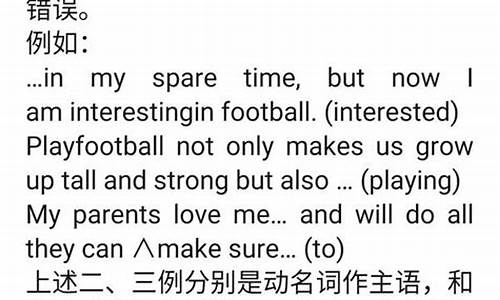您现在的位置是: 首页 > 教育研究 教育研究
高考反义疑问句_高考反义疑问句真题
tamoadmin 2024-05-28 人已围观
简介1.反义疑问句的用法2.反义疑问句英语句型是什么?3.英语反义疑问句的用法归纳4.反意疑问句一、反意疑问句中问句部分的动词与陈述部分的动词在语气上成相反的对应关系,即: 肯定+否定? 否定+肯定?如: ①You can’t do it, can you? ②They are very late for the meeting, aren’t they? 二、 反意疑问句中问句部分的动词
1.反义疑问句的用法
2.反义疑问句英语句型是什么?
3.英语反义疑问句的用法归纳
4.反意疑问句

一、反意疑问句中问句部分的动词与陈述部分的动词在语气上成相反的对应关系,即:
肯定+否定? 否定+肯定?如:
①You can’t do it, can you? ②They are very late for the meeting, aren’t they?
二、 反意疑问句中问句部分的动词与陈述部分的动词种类要对应一致。如:
①He has supper at home every day, doesn’t he? (不能用hasn’t he?)
②They have known the matter, haven’t they? (不能用don’t they?)
三、 反意疑问句中问句部分的动词在时态上应和陈述部分的时态一致。如:
①They will go to town soon, won’t they?(不能用don’t they?或 aren’t they?)
②He works very hard, doesn’t he?(不能用didn’t he?或won’t he?)
四、 反意疑问句的陈述部分含有由un-, im-, in-, dis-, 等否定意义的前缀构成的词语时,陈述部分要视为肯定含义,问句部分用否定形式。如:
①Your father is unhappy, isn’t he?(不能用is he?)
②The man is dishonest, isn’t he? (不能用is he?)
③It is impossible to learn English without remembering more words, isn’t it?(不能用is it ?)
五、反意疑问句的陈述部分带有little, few, never, hardly, seldom等否定意义的词时,问句部分用肯定式。如:
①She never tells a lie, does she?(不用doesn’t she?)
②He was seldom late, was he?(不用wasn’t he?)
六、反意疑问句的陈述部分为I am……时,问句部分习惯上用aren’t I?表示。如:
I am a very honest man, aren’t I?
七、反意疑问句的陈述部分为I(We) think(believe, suppose, consider) + that从句时,问句部分的动词及主语与that从句内的动词和主语保持一致。如:
①I think that he has done his best, hasn’t he?
②We think that English is very useful, isn’t it? (不用don’t we?)
八、反意疑问句的陈述部分为I(We) don’t think(believe, suppose, consider)+ that从句时,从句为否定意义,问句部分的动词和主语仍与that从句保持一致且用肯定式。如:
①I don’t think that you can do it, can you? (不用do I?)
②We don’t believe that the news is true, is it? (不用do we?)
九、反意疑问句的陈述部分为非第一人称主语+ think(believe, suppose, consider) + that从句时,问句部分的动词和主语与陈述部分的主句动词和主语保持一致。如:
①They all think that English is very important, don’t they? (不用isn’t it?)
②He didn’t think that the news was true, did he? (不用wasn’t/ was it?)
十、反意疑问句的陈述部分为主语+said( told, reported, asked……) + that从句时,问句部分的动词和主语与陈述部分的主句动词和主语保持一致。如:
①They said that you had finished your work, didn’t they? (不用hadn’t you)
②Kate told you that she would go there, didn’t she? (不用wouldn’t she?)
十一、陈述部分的主语为不定代词something, anything, nothing, everything时,问句部分的主语用it。如:
①Something is wrong with the computer, isn’t it?②Nothing has happened to them, has it?
十二、陈述部分的主语为不定代词somebody(someone), anybody(anyone), nobody(no one), everybody(everyone)时,问句部分的主语用he或 they,这时问句动词的数应和he或 they一致。如:
①Someone has taken the seat, hasn’t he?
②Everyone has done their best in the game, haven’t they?
十三、陈述部分为Let me……时,问句部分习惯上用shall I? 或will you?形式。如:
Let me have a try, shall I?(will you?)
十四、陈述部分为Let us……时,问句部分习惯上用will you?形式。如:
Let us stop to rest, will you?
十五、陈述部分为Let’s……时,问句部分习惯上用shall we?形式。如:
Let’s go home together, shall we?
十六、陈述部分用上述情况以外的祈使句时,问句部分一般用will you?形式表示请求,用won’t you?形式表示委婉请求或邀请。如:
①Do sit down, won’t you?/ will you? ②You feed the bird today, will you?
③Please open the window, will you?(won’t you?)
十七、陈述部分为否定祈使句时,问句部分一般用will you?形式。如:
Don’t make any noise, will you?
十八、陈述部分为There (Here) + be + 主语时,问句部分用动词+there(here)?形式。如:
①There are two cakes on the plate, aren’t there? ②Here is a story about Mark Twain, isn’t here?
十九、陈述部分用had better +原形动词表示建议时,问句部分用hadn’t +主语?形式。
①You’d better tell him about the matter, hadn’t you?
②We had better do it by ourselves, hadn’t we?
二十、陈述部分用used to +主语时,问句部分用didn’t + 主语?或usedn’t +主语?形式。
①He used to live in the country, didn’t he?/usedn’t he?
②They used to be good friends, didn’t they?/usedn’t they?
二十一、陈述部分用must(may, might) + have + V-ed表示推测时,若句中带有明显的过去时间的状语,问句部分动词用过去时形式。如:
①He might have forgotten his pen in the classroom yesterday, didn’t he?
(不用mightn’t he?/ hasn’t he?)
②You must have got up late this morning, didn’t you?(不用mustn’t you?/haven’t you?)
二十二、陈述部分用must(may, might) + have + V-ed表示推测时,若句中没有带明显的过去时间的状语,问句部分动词用现在完成时形式。如:
①Everyone must have known the death of the waitress, haven’t they? (不用mustn’t they?)
②You must have worked there a year ago, didn’t you?(不用mustn’t you?/ haven’t you?)
二十三、陈述部分的主语为从句时,问句部分的主语一般用it代替,如:
①What he said is true, isn't it? (不用didn’t he?)
②Where we will build the dam has not been decided yet, has it? (不用won’t we?)
二十四、陈述部分的主语为动名词或不定式时,问句的主语用it代替。如:
①To do one good deed is easy for a person, isn't it?
②Skating is your favorite sport, isn't it?
反义疑问句的用法
本题涉及下面语法
1、陈述部分用must(may, might) + have + V-ed表示推测时,若句中带有明显的过去时间的状语,问句部分动词用过去时形式。如:
①He might have forgotten his pen in the classroom yesterday, didn’t he?
(不用mightn’t he?/ hasn’t he?)
②You must have got up late this morning, didn’t you?(不用mustn’t you?/haven’t you?)
2、陈述部分用must(may, might) + have + V-ed表示推测时,若句中没有带明显的过去时间的状语,问句部分动词用现在完成时形式。如:
①Everyone must have known the death of the waitress, haven’t they? (不用mustn’t they?)
②You must have worked there a year ago, didn’t you?(不用mustn’t you?/ haven’t you?)
竭诚相助,希望采纳!!!
反义疑问句英语句型是什么?
反意疑问句又叫附加疑问句,是在陈述句之后,对陈述句所叙述的事实提出的疑问。其基本结构有两种:一是“肯定陈述句+简略否定问句”;二是“否定陈述句+简略肯定问句”。反意疑问句的前后两部分在时态、人称和数上都要保持一致。如:
It looks like rain, doesn't it﹖
He doesn't need to work so late, does he﹖
学习反意疑问句,特别要注意以下的一些特殊情况:
1.陈述部分的主语是this, that时,疑问部分的主语多用it;陈述部分的主语是these, those时,疑问部分的主语多用they。如:
This is a dictionary, isn't it﹖
Those are shelves, aren't they﹖
2.陈述句如果是there be结构时,疑问部分仍用there。如:
There once was a man named Saint Nicholas, wasn't there﹖
3.陈述部分的谓语是had better(最好)时,疑问部分用hadn't来体现。如:
You'd better have a good rest, hadn't you﹖
4.陈述句的谓语动词是have(has)to(必须)时,疑问部分用助动词do或does来体现。如:
They have to go there, don't they﹖
He has to leave early, doesn't he﹖
5.陈述句中的谓语动词是wish时,疑问部分常用may来体现。如:
You wish to go home, may you﹖
6.在英语口语中,“I am+表语”结构,后面的反意疑问句多用aren't I来体现。如:
I am very interested in learning English, aren't I﹖
7.陈述句的主语是动词不定式、动词的ing形式或从句时,疑问部分的主语多用it来体现。如:
Taking care of our environment is very important, isn't it﹖
What he said is right, isn't it﹖
8.陈述句中含有not、no、hardly、neither、never、few、little、too…to等否定词或具有否定意义的词时,疑问部分常用肯定形式。如:
Few people knew the news, did they﹖
Tom has never been to England, has he﹖
但陈述句中如果带有否定意义的前缀和后缀的单词时,整个句子仍视为肯定句,反意疑问部分多用否定形式。如:
She is unhappy, isn't she﹖
9.陈述句中的谓语动词含有“推测”性的词must(一定)时,反意疑问部分多与must之后的动词形式和时态与句子主语保持一致。
Her mother must be a teacher, isn't she﹖
She must have read the novel, hasn't she﹖
10.陈述句的主语是nobody, no one, everyone, somebody等不定代词时,反意疑问部分的主语多用they,如果陈述句的主语是something,nothing,anything,everything等不定代词时,反意疑问部分的主语多用it。如:
Nobody says a word about the accident, do they﹖
Everything seems all right, doesn't it﹖
11.陈述句是主从复合句时,如果主句的谓语动词是think、believe、expect、feel、guess等词,且主语是第一人称I时,反意疑问部分的人称、时态要与从句中的人称、时态保持一致,同时还要考虑到否定的转移。如:
I believe that the boy can get a ticket for you, can't he﹖
I don't think he will come, will he
8.以Let us开头的祈使句之后用will you反问,而以Let's开头的祈使句之后却用shall we反问。不过意思有所不同,Let us表示“征求对方的意见,让我们……,你同意吗?(不包括对方)”;而Let's则表示“让咱们(一块)……,好吗?(包括对方)”。如:
(15)Let us gather at the school gate,will you?我们在校门口集合,你同意吗?〈你本人不去〉
(16)Let's gather at the school gate,shall we?咱们在校门口集合,好吗?〈你本人也要去〉
should 仍用should来反意
1.如果陈述部分包含seldom,never,rarely,scarcely,few,little, nothing,nowhere等半否定词或否定词,附加疑问句部分的动词用肯定形式。如:
①He seldom goes to the cinema,does he?
②There is nothing wrong,is there?
2.如果陈述部分的否定词是由否定前缀或后缀如im-,un-,in-,ir-,dis-,-less等构成的,该否定部分作肯定处理,附加疑问部分仍用否定形式。如:
③Mike is hopeless,isn't he?
④His brother dislikes to eat potatoes,doesn't he?
3.当陈述部分是一个带有 that分句作宾语的主从结构时,附加疑问句部分一般与主句的主语和谓语动词保持对应关系。如:
⑤Mary says that John is right,doesn't she?
4.当陈述部分为带that分句的主从结构,且主句为I suppose,I think,I believe等结构时,附加疑问部分的主谓语与that从句保持一致,但这时要注意否定的转移。如:
⑥I don't think you can finish the task on time,can you?
⑦I suppose that he knows the secret of the Greens,doesn't he?
5.陈述部分带有情态动词 used to时,附加疑问部分用used或 use或did。如:
⑧Peter used to swim in winter,usedn't /usen't /didn't he?
6.can't用于表示推测,作“不可能”解时,附加疑问部分须根据 can't的动词选用相对应的形式。如:
⑨Betty can't be a student,is she?
⑩The workers can't have finished their work,have they?
7.当m ust表示“推测”含义时,其反意疑问句有两种情况:
1)当前文句子带有must be,must do时,附加疑问句用适当形式。如:
(11)She must be from Britain,isn't she?
(12)She must come from Britain,doesn't she?
2)当陈述句中带有m ust have done,且有过去时间状语,附加问句用didn't反问;不带过去时间状语时,附加问句则用haven't或hasn't。如:
(13)You must have seen the film last week,didn't you?
(14)You must have seen the film,haven't you?
8.以Let us开头的祈使句之后用will you反问,而以Let's开头的祈使句之后却用shall we反问。不过意思有所不同,Let us表示“征求对方的意见,让我们……,你同意吗?(不包括对方)”;而Let's则表示“让咱们(一块)……,好吗?(包括对方)”。如:
(15)Let us gather at the school gate,will you?我们在校门口集合,你同意吗?〈你本人不去〉
(16)Let's gather at the school gate,shall we?咱们在校门口集合,好吗?〈你本人也要去〉
9.陈述部分为并列句时,尾句对后一个分句进行反问。如:
(17)It's her daughter's wedding next week and she will try her best for that,won't she?
10.陈述部分含有had better时,附加问句部分仍用had反问;含有have to或has to或had to时,用 don't或doesn't或didn't反问。如:
(18)You had better have a rest,hadn't you?
(19)Rose has to clean the classroom,doesn't she?
(20)George had to raise four children and his wife,didn't he?
反意疑问句的一些特殊形式和用法
就对反意疑问句的一些特殊形式和用法讲述一下,供同学们在复习时参考。
1.如果陈述部分包含seldom,never,rarely,scarcely,few,little, nothing,nowhere等半否定词或否定词,附加疑问句部分的动词用肯定形式。如:
①He seldom goes to the cinema,does he?
②There is nothing wrong,is there?
2.如果陈述部分的否定词是由否定前缀或后缀如im-,un-,in-,ir-,dis-,-less等构成的,该否定部分作肯定处理,附加疑问部分仍用否定形式。如:
③Mike is hopeless,isn't he?
④His brother dislikes to eat potatoes,doesn't he?
3.当陈述部分是一个带有 that分句作宾语的主从结构时,附加疑问句部分一般与主句的主语和谓语动词保持对应关系。如:
⑤Mary says that John is right,doesn't she?
4.当陈述部分为带that分句的主从结构,且主句为I suppose,I think,I believe等结构时,附加疑问部分的主谓语与that从句保持一致,但这时要注意否定的转移。如:
⑥I don't think you can finish the task on time,can you?
⑦I suppose that he knows the secret of the Greens,doesn't he?
5.陈述部分带有情态动词 used to时,附加疑问部分用used或 use或did。如:
⑧Peter used to swim in winter,usedn't /usen't /didn't he?
6.can't用于表示推测,作“不可能”解时,附加疑问部分须根据 can't的动词选用相对应的形式。如:
⑨Betty can't be a student,is she?
⑩The workers can't have finished their work,have they?
7.当m ust表示“推测”含义时,其反意疑问句有两种情况:
1)当前文句子带有must be,must do时,附加疑问句用适当形式。如:
(11)She must be from Britain,isn't she?
(12)She must come from Britain,doesn't she?
2)当陈述句中带有m ust have done,且有过去时间状语,附加问句用didn't反问;不带过去时间状语时,附加问句则用haven't或hasn't。如:
(13)You must have seen the film last week,didn't you?
(14)You must have seen the film,haven't you?
8.以Let us开头的祈使句之后用will you反问,而以Let's开头的祈使句之后却用shall we反问。不过意思有所不同,Let us表示“征求对方的意见,让我们……,你同意吗?(不包括对方)”;而Let's则表示“让咱们(一块)……,好吗?(包括对方)”。如:
(15)Let us gather at the school gate,will you?我们在校门口集合,你同意吗?〈你本人不去〉
(16)Let's gather at the school gate,shall we?咱们在校门口集合,好吗?〈你本人也要去〉
9.陈述部分为并列句时,尾句对后一个分句进行反问。如:
(17)It's her daughter's wedding next week and she will try her best for that,won't she?
10.陈述部分含有had better时,附加问句部分仍用had反问;含有have to或has to或had to时,用 don't或doesn't或didn't反问。如:
(18)You had better have a rest,hadn't you?
(19)Rose has to clean the classroom,doesn't she?
(20)George had to raise four children and his wife,didn't he?
希望对你有帮助:)
英语反义疑问句的用法归纳
一、"前肯后否"型句式
He is a student,isn't he?
他是一个学生,不是吗?
Yes,he is.
是的,他是。
No,he isn't.
不,他不是。
二、"前否后肯"型句式
He isn't a student,is he?
他不是一个学生,对吗?
Yes,he is.
不,他是。
No,he isn't.
对,他不是。
反义疑问句注意事项
(1)如果陈述部分含有never, seldom,hardly,few, little, nothing, none等表示否定意义的词时,后面的反意疑问句要用肯定形式。
(2)当陈述部分含有un-前缀、-less后缀等表示否定意义的词时,例如:unhappy, dislike等,我们要把他当做肯定句处理,疑问部分还用否定形式。
反意疑问句
英语反义疑问句的用法归纳如下:
1、当陈述句的主语为anybody, anyone, everybody, everyone, somebody, someone, nobody, no one时,反意疑问句的主语用they。也可用he,尤其是nobody, no one等作主语,
具有否定概念时。如:
Somebody phoned while I was out, didn’t they?
Everyone enjoyed the party, didn’t they?
Nobody wants to go there, does he?
Nobody says a word about the incident, don’t they?
Somebody borrowed your bike yesterday, didn’t they?
Anybody can do it, can’t they?
2、当陈述部分的主语是I,而句子又用来征询对方的意见时,附加疑问句中的主语用you。如:
I find English very interesting, don’t you?
I don’t like that film, do you?
3、当陈述句的主语为everything, anything, nothing, something等时,反意疑问句的主语用it.
如:Everything is all right, isn’t it?
Nothing can stop us going forward, can it?
4、当陈述部分的主语是指示代词this, that或these, those时,附加疑问句中的主语分别用it和they。
如:This is important, isn’t it?
That isn’t correct, is it?
These are your friends Tom and Jack, aren’t they?
Don't talk loudly in the library, will you?
英语18种特殊的反意疑问句
介绍
1.祈使句。祈使句后一般加上will you或won't you构成反意疑问句,用will you 多表示“请求”,用won't you 多表示提醒对方注意。例如: Look at the blackboard, will you/ won't you?看黑板,好吗? Let引导的祈使句有两种情况: 1)Let's...,后的反意疑问句用shall we或shan't we。例如: Let's go home, shall we/ shan't we? 回家吧,好吗? 还可以用may I来表示征求对方的同意或许可。 2)Let us/me...后的反意疑问句用will you或won't you。例如: Let me have a try, will you/won't you? 让我试一试,行吗? 2.感叹句。感叹句后加反意疑问句时,其反意疑问句需用be的一般现在时态的否定形式。例如: What fine weather, isn't it? 多好的天气啊,是吧? 3. 当陈述部分谓语动词是need, dare, used to,且这些词被用作实义动词时,其反意疑问句需用do的适当形式。例如: He needs help, doesn't he?他需要帮助,是吗? 4.陈述部分主、谓语是I am...时,反意疑问句用aren't I 或am't I ,而不是am not I (可用am I not)。例如: I'm working now, am't I? 我在工作,是吗? 5.陈述部分的主语是everything, nothing, anything或something 时,反意疑问句的主语应用代词it。例如: Something is wrong with my radio, isn't it? 我的收音机出毛病了,是吧? 6.陈述部分的主语是 everybody, everyone, anybody, anyone, somebody, someone, nobody, no one, none, neither 时, 其反意疑问句的主语需用复数代词they。例如: Everyone is here, aren't they? 大家都到了,是吗? No one knows about it, do they? 没有人知道这件事,对吗? 7.陈述部分的主语是指示代词this或that时,反意疑问句的主语用it,当陈述部分的主语是指示代词these或those时,其反意疑问句的主语用they。例如: This is a plane, isn't it? 这是一架飞机,是吗? These are grapes,aren't they? 这些是葡萄,是吗? 8.陈述部分的主语是不定代词one时,反意疑问句的主语可以用one,也可用you(美式英语用he)。例如: One should be ready to help others, shouldn't one? 每个人都应该乐于助人,是吧? 9.当陈述部分含有以下这些含有否定意义的词时:few, little, seldom,hardly, never, not, no, no one, nobody, nothing, none, neither等,其反意疑问句需用肯定结构。例如: He is never late for school, is he? 他上学从不迟到,是吗? 10.当陈述部分所含的否定词是通过加前缀或后缀构成的,其后的反意疑问句依然用否定结构。例如: It is unfair, isn't it? 这不公平,是吧? 11.含有否定含义的词在陈述部分作动词的宾语时,其反意疑问句用肯定结构,也可以用否定结构。例如: You got nothing from him, did you? 你从他那儿什么也没得到,是吗? 12.当陈述部分主语是从句、不定式(短语)、动词-ing形式时,反意疑问句的主语应该用it。例如: What you need is more important, isn't it?你需要的东西更重要,是吧? 13.当陈述部分含I think (believe, suppose...)that... 结构时,其反意疑问句须与从句的主、谓语保持一致,注意主句的主语必须是第一人称。例如: I don't think he will come, will he? 我认为他不会来,对吗? 14.have(has)不是表示“有”的意思,并在句中做谓语时,其反意疑问句的助动词要用do, does, did。例如: They had a meeting just now,didn't they? 他们刚才开了个会,是吗? 15.陈述部分有have to 时,其反意疑问句要用助动词的否定形式。例如: You have to water the vegetables every day, don't you?你每天都要浇菜,对吧? 16.陈述部分是there be句型时,其反意疑问句中要用there。例如: There was a hospital here, wasn't there? 过去这儿有家医院,是吗? 17.陈述部分有had better时,反意疑问句中要用hadn't。例如: We had better go to school at once, hadn't we? 我们现在最好马上去上学,好吗? 18.当陈述部分含有情态动词must时,我们便要分析一下must的含义。如果must 作“一定;要;必须”讲,反意疑问句须用mustn't或needn't;而当must作推测意义“一定是;必定”讲时,反意疑问句则需根据must后的动词原形选用相应的形式。例如: He must work hard at physics, mustn't he? 他必须努力学物理,是吧? Tom must be at home,isn't he? 汤姆一定在家,是吧?
反意疑问句的回答
在回答的时候, 如果是前肯后否的句子,思维和中国人相同;如果是前否后肯的句子,思维正好同中国人相反: He is a student, isn't he? (他是个学生,不是吗?) Yes, he is.(是的,他是学生) No, he isn't.(不是,他不是学生) He doesn't like playing football, does he?(他不喜欢踢球,是吗?) Yes, he does.(不是,他喜欢踢球) No, he doesn't.(是的,他不喜欢踢球) I am not a teacher, am I? (我不是一名老师,是吗?) Yes, I am.(不是, 我是一名老师。) No, I am not.(是的,我不是一名老师。) 对反意疑问句的回答,无论问题的提法如何,如果事实是肯定的,就用yes,事实是否定的,就要用no。要特别注意陈述句部分是否定结构,反意疑问句部分用肯定式提问时,回答yes或no与汉语正好相反。这种省略回答的yes要译成“不”,no要译成“是”。 例 ---He likes playing football, doesn’t he? 他喜欢踢足球,不是吗? ---Yes, he does. / No, he doesn’t. ,是 他喜欢。/ 不 他不喜欢。 ---His sister didn’t attend the meeting, did she? 他妹妹没有参加会议,是吗? ---Yes, she did. / No, she didn’t. 不,她参加了。/ 是的,她没参加 若be动词后是never//few//little,后面的动词仍用肯定形式









